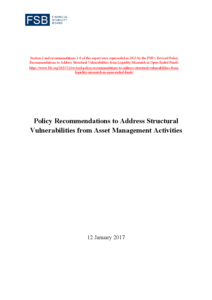This assessment of the effectiveness of the FSB’s Policy Recommendations to Address Structural Vulnerabilities from Asset Management Activities forms part of the FSB’s work programme to enhance the resilience of non-bank financial intermediation (NBFI). The assessment covered both the implementation and effectiveness of FSB Recommendations relating to liquidity mismatch in open-ended funds (OEFs) and took place in parallel with IOSCO’s review of the implementation of its own related Recommendations.
The report finds that authorities have made meaningful progress in implementing the 2017 FSB Recommendations and looks at progress in four key areas:
- Reducing structural liquidity mismatch
- Reducing shock amplification and transmission through the use of liquidity management tools (LMTs)
- Enhancing regulatory reporting, data availability and public disclosure
- Ensuring adequacy of stress testing
The report concludes that certain policy enhancements would strengthen the current framework and OEF liquidity management practices:
- Providing a clearer and more specific articulation of the intended outcome of policies to reduce structural liquidity mismatch in OEFs
- Ensuring that investors bear the costs of liquidity associated with fund subscriptions and redemptions, and enhancing the use, and consistency of use, of LMTs by fund managers
- Requiring clearer public disclosures from fund managers on the availability and use of LMTs, including by enhancing their engagement with investors
- Closing identified data gaps to improve authorities’ ability to monitor liquidity mismatch in OEFs and its management from a financial stability perspective
- Further promoting the use of fund- and system-level stress testing.
The FSB and IOSCO will carry out follow-up work based on the assessment’s findings. This will involve:
- revisions to the FSB and IOSCO Recommendations to address structural liquidity mismatch and promote greater inclusion and use of LMTs as well as to clarify the appropriate roles of fund managers and authorities in implementing these Recommendations;
- development of detailed guidance on the design and use of LMTs;
- work to enhance the availability of OEF-related data for financial stability monitoring; and
- steps to promote the use of stress testing.
Engagement with stakeholders, including through public consultation of the proposed revisions to the Recommendations and of the new guidance, will form a key part of this process.
The FSB and IOSCO will monitor the progress made by member jurisdictions in implementing their respective revised Recommendations. This monitoring will be followed up, once implementation is sufficiently advanced, with an assessment of the effectiveness of jurisdictions’ policy measures in addressing risks to financial stability from OEF liquidity mismatch.
